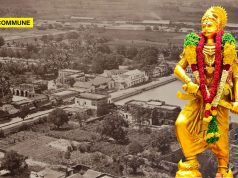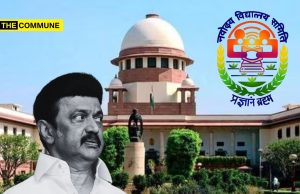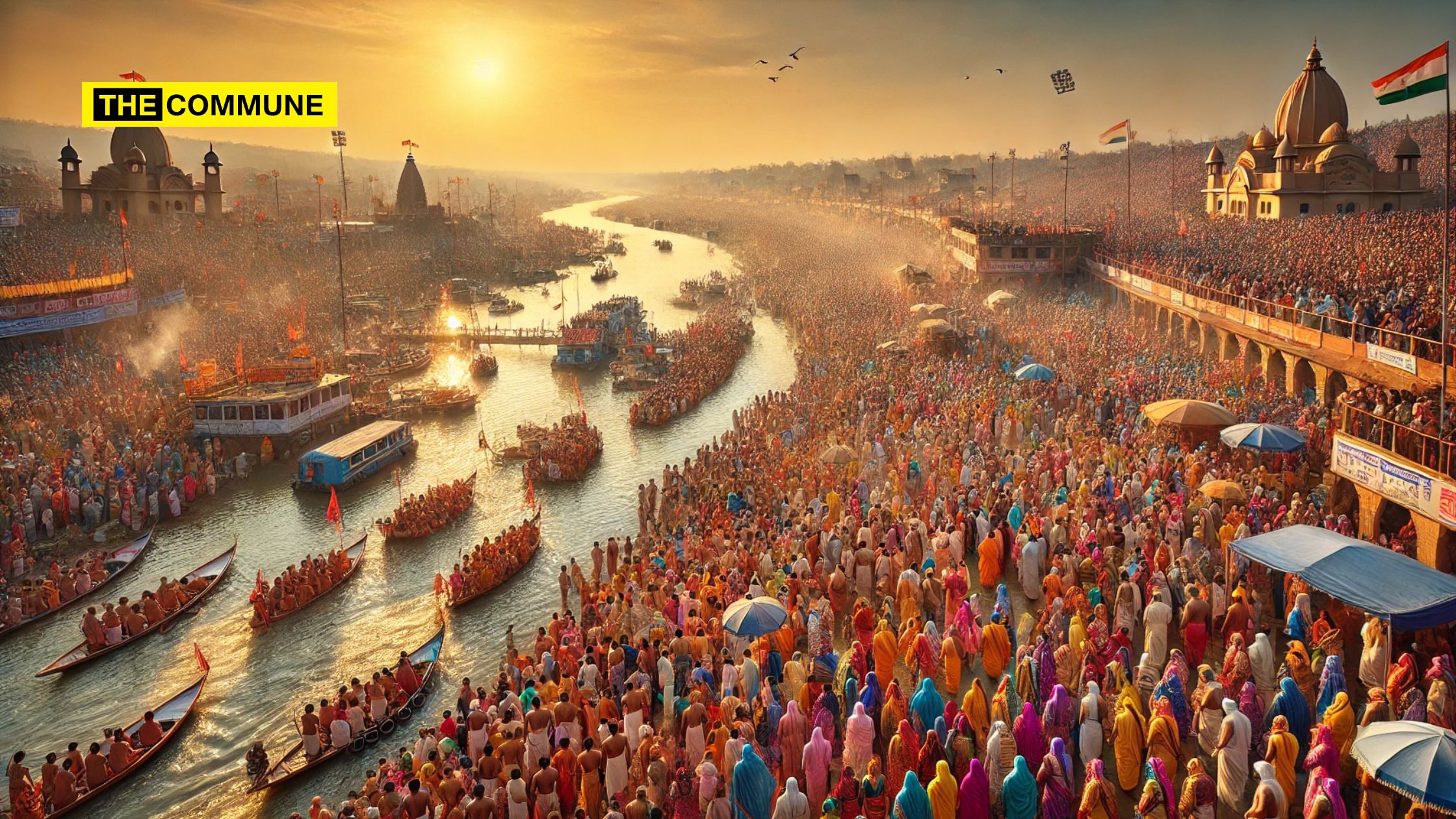

In his groundbreaking book, man’s search for meaning, Viktor E. Frankl notes: “Those who have a “why” to live, can bear with almost any “how””
I was reminded of this quote after my personal life-altering experience of Mahakumbh 2025 – Once in a century opportunity to participate and soak in the divinity amongst the ocean of sanatanis thronging the ghats of Prayagraj, upholding the sacred traditions of our ancestors. The decision to embark on this “teerth yatra” was an instantaneous one & with 3 of my colleagues, I embarked on a journey into the unknown as this was not just my first trip to Uttar Pradesh, but also a visit to the holiest of all festivals in our Sanatana Dharma.
Historicity & Metaphysical Significance
Kumbh or Kumbh Mela is celebrated once every 12 years with a specific astronomical cum astrological alignment of planets. The mela that happens at the end of 12 such cycles i.e. 12 kumbhs is Mahakumbh, which is ongoing in Prayagraj in 2025. Starting around Makara Sankranti and going up to Maha Shivaratri, this event draws crowds from various corners of the globe, each with their own journey to discover.
Mahakumbh is celebrated to honour the Samudra Manthana, the churning of the Milky Ocean by Devas and Daityas, in search of the elusive elixir, Amrutha. The legend goes on that due to certain events, 4 drops of nectar fell in 4 different places viz., Haridwar, Prayagraj, Ujjain & Nashik, which is where Kumbh is celebrated every 12 years.
The events of Samudra Manthana i.e. various items like Airavata, Uchchaisravas, Apsaras, Kaustubha, Kamadhenu, etc along with the deadly poison Halahala & the potion of immortality, Amrutha that come up from the ocean, are beautifully illustrated on the walls of the city. When one takes a ride through the city, it is impossible to miss these beautiful illustrations.
I can’t help but reflect on these celestial events in a more metaphysical sense. Isn’t the Samudra Manthana an ongoing process within our souls? I believe this is a metaphor for the journey of a human into discovering his own self and breaking the barriers or the clutches of Maya and transcending the path towards the divine. Halahala & Amrutha can be considered as the states of mind where we are influenced by the various vices i.e. Shadripus.


Event Organisation
An event of such magnitude requires humongous preparation and rallying of resources to facilitate and host such a surge of humanity, averaging 1.5 Crore every day. The local administration should be applauded and appreciated very highly for ensuring a relatively smooth experience for one and all. The central and state governments should be very highly appreciated for organising an event of such proportions. Some of the standout features are:
- Enormous number of portable Toilets with uninterrupted water supply
- Similarly, innumerable bath chambers or changing rooms are constructed
- Entirely new cities i.e. Tent Cities erected on the banks of the Ganga to provide world-class accommodation to seekers.
- Roads constructed with steel plates for commuting over these banks
- A large number of Pontoon Bridges were built for easy commute of people walking or using vehicles – All are one-way routes including for those going by foot.

While these facilities were top-notch and should be celebrated & studied widely, there were some specks of discomfort amongst the yatris. Numerous Barricades, abrupt traffic restrictions due to VVIP presence, and unavailability of resources did draw the ire of some. One aspect that stood out was the preferential treatment of VVIPs compared to the common man. While this is an expected outcome in an event of such significance and magnitude, it did put the seeker to some discomfort, with a very steep price to pay economically. In the future, I hope the authorities plan this aspect better with dedicated slots or days or spots for VVIPs while providing similar flexibility to the common man.
Economics
Mahakumbh should be a definitive study in the economic model that has been unleashed is of a humungous proportion. Numerous businesses have sprung up, thereby providing an opportunity to make a better living, which I feel is perhaps an understated aspect of this event.
Stores selling everyday essentials like soap, oils, pooja items, water, juices, rudraksha, etc can be found literally at every step. On closer observation, one can appreciate the sacrifices being made by entire families to eke out a better outcome at every juncture. One example that stuck with me was this Amul outlet near my tents, which is essentially run by a family who had perhaps migrated from Odisha (guessing from the name) lock, stock, and barrel. Utilising the facilities of toilet provided by the government, this family is struggling hard to make a profit economically, while braving the sharp cold at night. They don’t have the luxury of the tents like the yatris do but sleep in a makeshift tent erected using their sarees and clothes. The economic disparity is glaring at times, but the spirit is heart-warming.
Businesses, small and big were spread out over the entire Mela area and beyond. While the corner stores that sold essentials were a common sight, corporate conglomerates weren’t far behind.
- Corporate Brand Presence: Brands like Dominos Pizza, Pizza Hut, Vaango, Campa, etc had an equally ubiquitous presence everywhere. Amul had a towering presence for milk products while some other milk brands were observed in other places.
- Bike Taxis: An innovation that I encountered first in the Mahakumbh Mela. Essentially, a bike rider takes 2/3 people along with him on his bike and ferries them from one point to another for a charge. These charges are not small for a common man, but quite affordable for a middle-class person. Bike riders from all over Prayag and perhaps outstation have made the Sangam area their base and generating revenue like no other.
- E-rickshaws: This is perhaps the most eye-opening moment of my trip. The sheer adoption and widespread implementation of electic rickshaws to transport yatris from one point to another is simply mind-boggling. This widespread prevalence is not limited to Prayagraj but was observed with equal fervour in both Kashi and Ayodhya (two other stops of our trip). Electric vehicles have certainly got a huge boost due to the Mahakumbh.
Environmental Impact
Events of such large magnitude tend to draw their own share of opposition, especially related to environmental topics. However, what one observes in the Mela and beyond i.e. in other cities, should become a lesson to be adopted closer home.
Food was available everywhere for free. Though we were lucky to have our food in our camp, I did observe that all religious institutions were serving food to every yatri who passed through their gates. This food was served on dry-leaf plates which are easily bio-degradable and environment friendly.
Apart from the toilets, one of the most stand-out features of this mela was the huge spread of Water Banks – places to distribute potable drinking water. One was not limited to buying the branded mineral water but could easily fill their bottles with drinking water at every possible junction. This is a HUGE achievement of this mela and its administrators.
Chai, an eternal favourite and life saver in cold conditions, was served in Kullads, clay cups that were disposed of after use. A simple, but beautiful innovation that reduces water usage (due to the requirement of cleaning in the case of steel glasses) and eliminates the fear of hygiene, given the monstrous proportions of the population walking through the roads of Prayag. Wherever Kullads weren’t available, I observed paper cups (not the preferred solution) were used.
Overall, this mela is a macrocosm of many various microcosms each with its own business and economic objectives. While one drives through the Mela area, one can’t help but empathise with the families for the conditions they are currently in but also feel proud about their self-reliance and ethos.
Finally, the beauty of this meal can be understood by appreciating the fact that the entire ecosystem is temporary and shall be dismantled upon the culmination of the Mahakumbh. In fact, many event organisers and some religious institutions have already started dismantling their structures. Excellently planned & executed.
Temples – What To Visit
Prayagraj is home to many ancient temples with a very interesting history. Owing to the surging crowd and the sheer complexity of getting around, we could visit only a few temples in the divine place, but with very interesting itihasa attached to them.
Someshwar Mahadev
This is a linga supposed to have been consecrated by Soma / Chandra while performing tapas to please Shiva. From the Puranas, we learn that Daksha Prajapati had cursed his son-in-law Chandra for favouring Rohini over the other 26 wives he had married. Ill-fated with leprosy, Chandra prays to Mahadeva here to overcome this ailment. The linga is very beautiful and can be prayed through Abhisheka. One unique feature of Lingas in the northern part of our divine land is that we can touch the Linga and garner our blessings from the same.
From the main road, en route to this temple, there is a unique temple dedicated to the 3 river devis i.e. Ganga, Yamuna, and Saraswati that make Prayagraj, truly “Teerth Raj”. The simplicity is quite jarring, but the divinity is unmistakable.
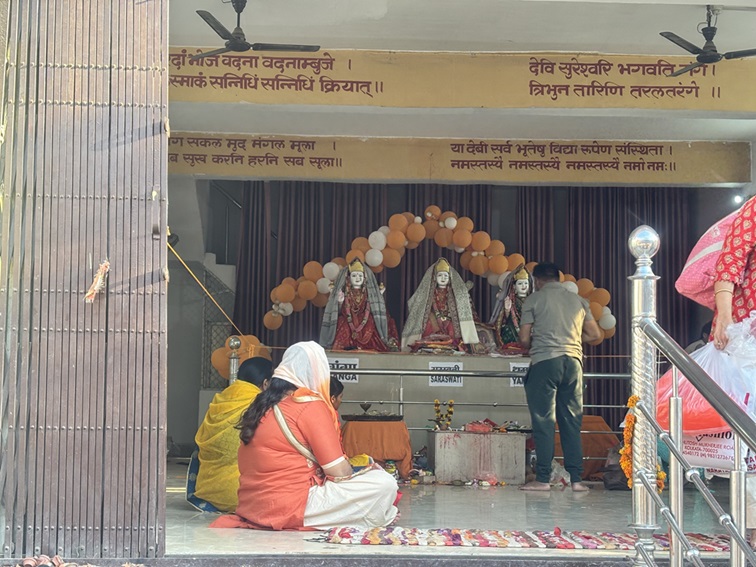
Nageshwar Mahadev
This is a temple adjoining a Ghat constructed for bathing purposes. This was situated opposite to our tent, and we walked to this kshetra, only to be greeted by a majestic Linga. Though there are no written records, the main priest shared that no one knows the antiquity of this temple, except that the linga was a udbhava (self-generated) linga coming up from Patala Loka. An unknown treasure is hidden amongst the bylanes of the divine city.
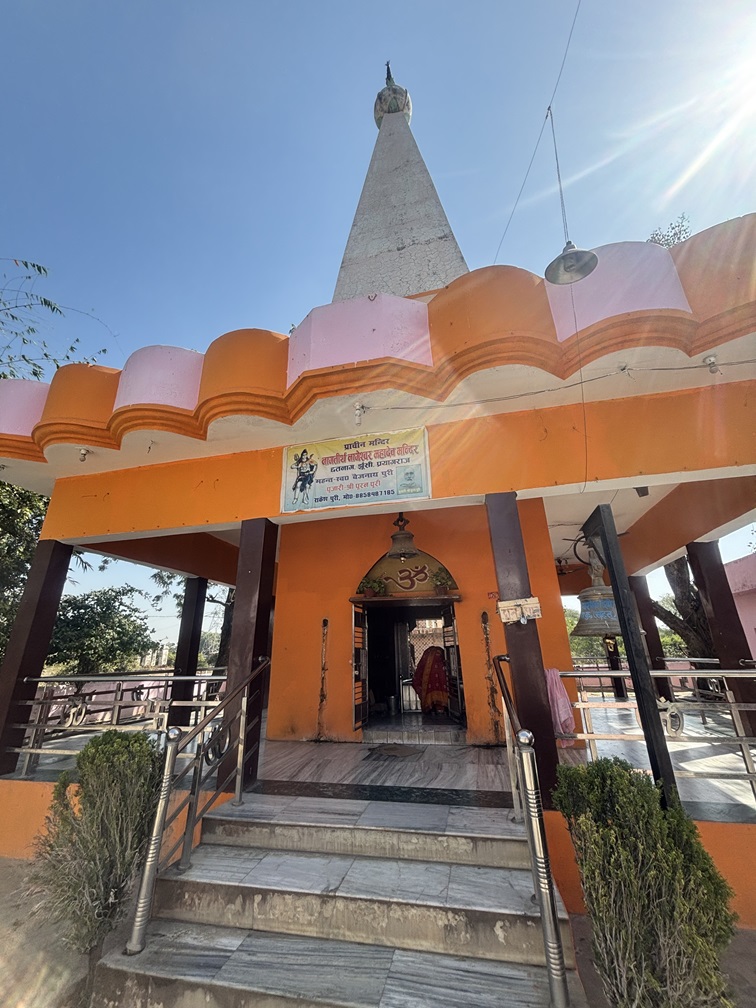
Nag Vasuki Kshetra
One of the must-visit places in Prayagraj is the ancient Nag Vasuki temple, dedicated to Vasuki, the serpent lord who was used as the Churning rope during the famous Samudra Manthana. The Moorthi of the Naga Devata is majestic and has an unknown charm attached to it. In the same complex, we can find temples dedicated to Mahadeva, Veni Madhav & other deities.
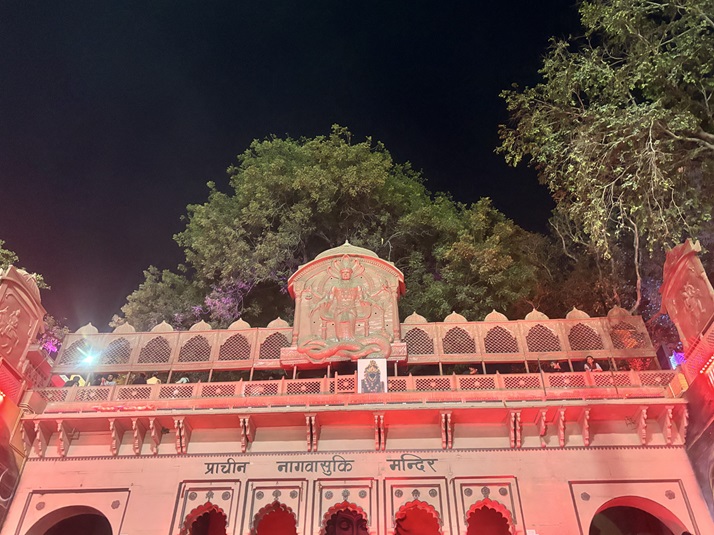

Akhadas
We visited Prayagraj in the middle of February, after Magha Pournima, and hence, many akhadas had already shifted their bases. While we were lucky to have walked through the famous Juna Akhada and Kinnar Akhadas, we weren’t lucky enough to meet some of the famous yogis and swamis. However, we could participate in the Mahamangalarathi in Kinnar Akhada and were lucky to meet Aghori Guru Sri Manikandan and the Mahamandaleshwar of Kinnar Akhada.
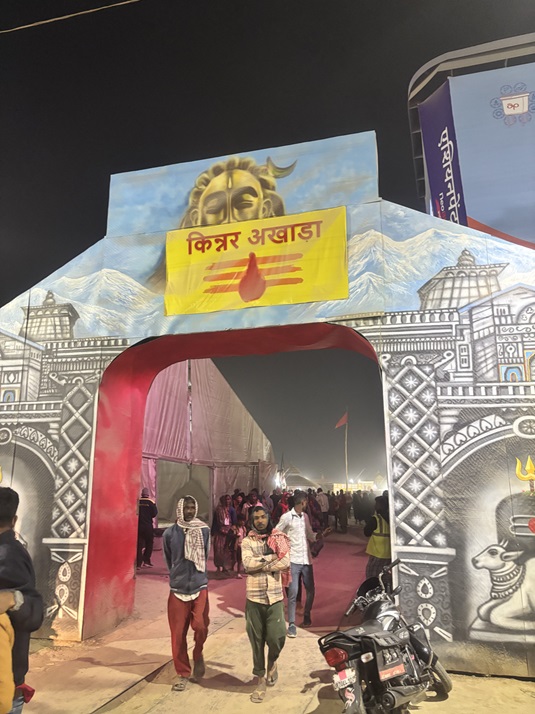
Perhaps, the life-altering experience that I can mention was the interaction with Naga Sadhus in Juna Akhada. One of my colleagues travelling with me had a unique experience, that literally left him stunned. Owing to privacy concerns, I am not reproducing the incident but suffice to say that it sent a chill down all of our spines.
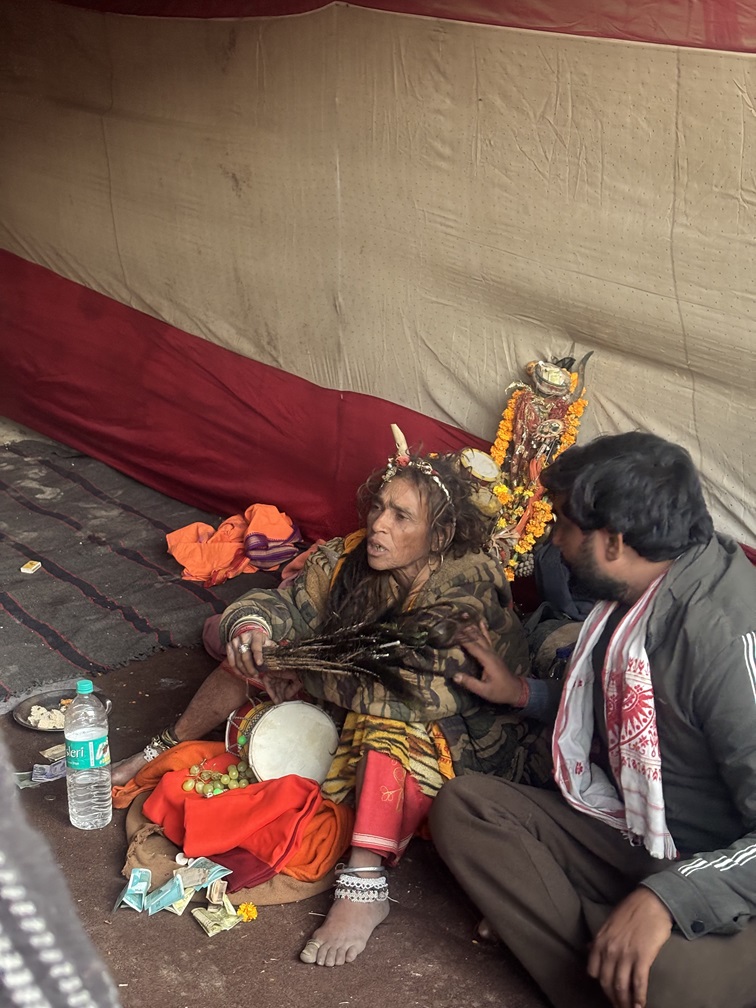
Near our camp, we also visited the permanent base of Sri Shambhu Panchayati Atal Akhada. The main Guru had just left for Mumbai, but speaking to the security guard, we learned that this is a Kashmir-based Akhada and is visited by the Mahaswami during Kumbh.

We did observe some very senior sishyas of the Akhada, but decided against disturbing them with conversation & just soaked in the divinity in the air.
Other Temples
Apart from these famous Akhadas, we also observed a very wonderful Sri Venkateshwara Swamy temple constructed in the Sangam area by TTD, as well as a majestic and imposing structure of ISKCON funded by one of India’s famous business tycoons and a camp of Mata Amritanandamayi with a complete mobile hospital bus parked nearby. It would be fair to summarise that almost every religious order of some denomination had their presence in this divine event & all their bhaktas could savour their trip through personal experiences.
Personal Experiences
Referring to the quote at the onset of this article, the “Why” part was initially flummoxing but became quite clear as the days became closer to our journey. Once the decision was set in the mind, the rest of the modalities became inconsequential. The “How” was easily managed at every step, even though we had our share of curve balls, both implementation-wise and economically. In this section, I would like to share the overrun of emotions in my mind and soul as I returned from the Mahakumbh.
First, one needs to visit Prayagraj to really appreciate the majesty and enormity of Maa Ganga. Our camp was established by a premier company in the famous Tent City of Prayagraj. When we spoke to locals, we understood that our camp was literally the middle of Ganga in her full flow i.e. 2.5 km wide river with water level going up to 70 feet during monsoons. This is a humungous amount of water that can’t be described but only can be comprehended by a personal visit. I would consider ourselves lucky that we could stay in her lap for 2 days and offer arghya & chant other mantras during sunrise, noon & sunset. Mother, who nourishes all her children alike with her benevolence and unconditional love.
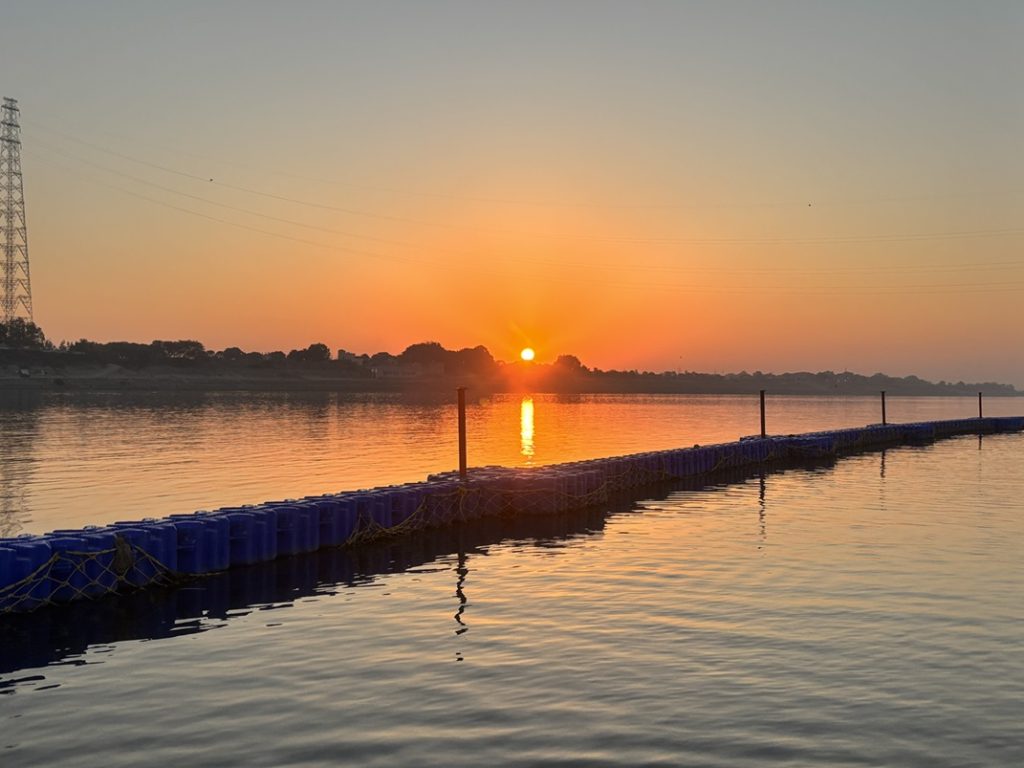
When we walked towards the Sangam area, we could observe wave after wave of devotees making their way to have their lifetime experience of bathing in the holy waters. The crowd cut across nationalities, regionalities, and economic spectra and was just a sight to behold. Some groups were implementing unique techniques to stay together, while there were some on their own steeped in their own adventures.
I would like to recollect an interesting incident here. When we walking towards the Ghat, a young man in his early 20s came and checked with me about the route to the bathing Ghat. Since we were going towards the same destination, he too tagged along with us. The conversation led to the realisation that we had similar ancestries originating from Kerala and that he was a young mind pursuing his law. Without knowing Hindi, he travelled to Kumbh to experience the atmosphere and derive his own perspectives of the event. This is just a one-off experience but is representative of many such inspiring stories from many quarters in the Kumbh. What struck me was one statement from the young chap: “Neither my grandfather would have participated in this event, nor will my grandchildren witness this majestic celebration”. Simple, yet very profound.
As we took the dip in the holy Sangam ghat, one can’t help but feel emotional and overwhelmed at the sheer confluence of various cultures, languages, ethnicities, and backgrounds at the festival of divinity. I always believe that every single spiritual step is pre-ordained by the omnipresent deity, and it was his/her design that we could take the dip amongst the millions of people assembled at that place. All of us are reflections of the almighty in some form and I felt an unexplainable connection with unknown faces – Sheer happiness for no apparent reason.
After finishing my pitru tarpana, as soon as I took my customary dip, I was requested by an elderly lady to perform visarjana of her kalasha / kumbha. Why she chose me amongst the millions around is quite unexplainable, but felt very blessed that I was able to perform this simple task. Standing in the water, as I observed as far as the horizon stretched, one could observe the various colours and rituals being performed by the huge crowd, I couldn’t help but reflect: We are divided in our approach, but our destiny and destination are the same – To connect with the divine.
As I left Prayagraj for my onward journey to Varanasi, I couldn’t help but reflect: Sanatana Dharma is alive and thriving and will always continue to do so for eons to come. Never doubt this aspect for the true citizens of this divine Bhoomi have spoken, quite clearly and loudly.
Jai Maa Gange !!!
Gee Vee is an engineer and avid fan of itihasas, puranas and books.
Subscribe to our Telegram, WhatsApp, and Instagram channels and get the best stories of the day delivered instantly.


